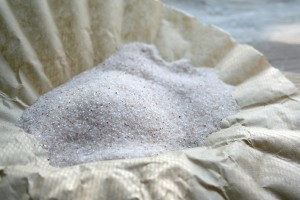This article is courtesy of endalldisease.com
 Salt has been treasured since the beginning of time for its life-giving properties. From the moment of conception, humans are never without a need for salt. Understand that we don’t need toxic, refined salt but living, unrefined salt.
Salt has been treasured since the beginning of time for its life-giving properties. From the moment of conception, humans are never without a need for salt. Understand that we don’t need toxic, refined salt but living, unrefined salt.
SALT: THE ESSENCE OF LIFE
Eating a low salt diet is widely believed to be a healthy choice. Is this true? It’s time to question this widely-believed dietary dogma.
No matter how much mineral content animals derive from plants in their diet, they still instinctively seek out natural salt licks in order to make their diets complete… or they die.
Dietary intake of salt is so vital that biological life as we know it cannot exist without it.
In this article we’re going to go over the importance of salt, and then make the essential distinction between healthy salt and unhealthy salt. The difference is similar to eating factory farmed beef pumped full of growth hormones vs. eating meat from animals that were fed on green pasture – one will kill you and one will nourish and heal you.
Salt: The Essence of Life
The function of the human body is entirely dependent upon its conductivity and the ability of it to transmit information electrically.
Every one of your 4 trillion cells has an electrical charge. The communication between your body’s cells and systems requires a proper environment for electrical signals and impulses to be exchanged.
No salt = no conductivity = no life!
We’ve all seen the experiment in highschool science class where we try to run electricity through distilled water (devoid of minerals) in attempts to complete a circuit and light up a light bulb. Here it is again in case you skipped that day of class to do mushrooms with your friends:
As you can see from the experiment, whether we drink distilled water, tap water, or river water, we need additional salt in order for the electrical signal to pass through it. Our bodies are at least 70% water, and if we compare the lit bulb to life itself, then it is fair to say that life cannot exist without salt.
Toxic Salt vs Healthy Salt
Toxic Salt: Refined Salt
The reason that salt has been shown in various studies to damage the body is because the salt used in those studies is toxic and is not fit for human consumption. Created from a high-heat refining process that removes virtually all the mineral content, refined table salt becomes a highly processed food that doesn’t even resemble real salt from nature.
Real salt from nature consists of about 84% sodium chloride and 16% other minerals and trace elements in a perfectly balanced matrix, whereas the composition of refined salt is about 97.5% sodium chloride and up to 2.5% chemical additives. The composition of refined salt significantly changes its effect in the body.
Let’s look at what is added to refined salt after it is stripped of it’s life-giving mineral content:
- Anti-caking agents such as aluminum are then added to the salt to make sure the grains of salt don’t stick together. (Excess aluminum is toxic to the body and brain.)
- Corn sugar (dextrose) has also been a typical additive to salt to keep it free-flowing.
- Potassium Iodide is then added because it’s an essential nutrient, but the problem is,
- Sodium Fluoride is also added, which cancels out the utilization of iodine in the body. (Sodium fluoride is toxic to the body and mind.)
- The salt is then bleached white for appeal. (Bleach is toxic to the body.)
Many people think that they’ve solved the problem by purchasing “Sea Salt” from their local health food store. This sea salt is refined just like table salt, and generally comes from the exact same refineries as refined table salt. It is no better than table salt, and the term “Sea Salt” is a complete misnomer.
Healthy Salt: Unrefined Salt
Healthy salt comes from the ocean. As Dr. Maynard Murray states in his book Fertility from the Ocean Deep, “The river of blood that sustains human beings is a copy of seawater. 90 trace elements in perfect solution.”
Over 90 minerals and trace elements exist within ocean water, they are in the exact proportions required by all biological life on earth. When ocean water is dried at low temperatures, the resulting salt that is produced has a healing blend of vital minerals. This is the way that salt has been produced for thousands of years.
Celtic Sea Salt has been produced using sustainable salt farming methods by hand off the Brittany Coast of France for centuries. It is dried naturally by the sun in clay ponds and gathered by hand with wooden tools in such a way that the living enzyme content remains fully in tact.
8 Benefits of Unrefined Sea Salt
1. Sinus or Bronchial Congestion – Celtic Salt draws mucous out of the body. Consuming unrefined sea salt will greatly increase the mucous blown out the nose and coughed up.
2. Nourishing the Adrenals – Your adrenal glands run on sodium, but what they need is not the toxic refined sodium chloride table salt, but a whole, unrefined salt.
3. Preventing Illness – More heavily salting food at the first signs of sickness can counteract the illness.
4. Better, Longer Sleep - Because of salt’s ability to calm the nervous system, generally results in longer, uninterrupted, more refreshing sleep.
5. Lower Blood Pressure – Refined, toxic table salt is an irritant to the body that can cause high blood pressure. Many people experience a lowering of blood pressure by using unrefined Salt.
6. Fluid Retention – Eat refined salt will increase fluid retention as the body tries to neutralize this toxin. Eat unrefined salt properly balance the body’s mineral content and release that retained water.
7. Trauma – Extra unrefined salt can be beneficial for shock, severe burns (not externally), hemorrhage, surgery and physical trauma.
8. Other Conditions – Unrefined salt is reported to help correct excess acidity, relieve allergies, relieve skin diseases, and restore better digestion through stimulating hydrochloric acid secretions.
Dietary Upgrade #3: Unrefined Ocean Salt
 Salt has been treasured since the beginning of time for its life-giving properties. From the moment of conception, humans are never without a need for salt. Understand that we don’t need toxic, refined salt but living, unrefined salt.
Salt has been treasured since the beginning of time for its life-giving properties. From the moment of conception, humans are never without a need for salt. Understand that we don’t need toxic, refined salt but living, unrefined salt.
I use a generous amount of unrefined ocean salt everyday on every meal I eat. The beautiful truth about salt is that when it is unrefined and in balance with other minerals it is not toxic. In fact, with unrefined salt you never have to worry about eating too much of it because the flavor governs itself. When you add salt to your food and the taste improves, that is a healthy amount of salt. When you’ve added too much salt to your food you won’t want to eat it.
I highly recommend you Upgrade Your Life and begin experiencing the benefits of unrefined salt!






